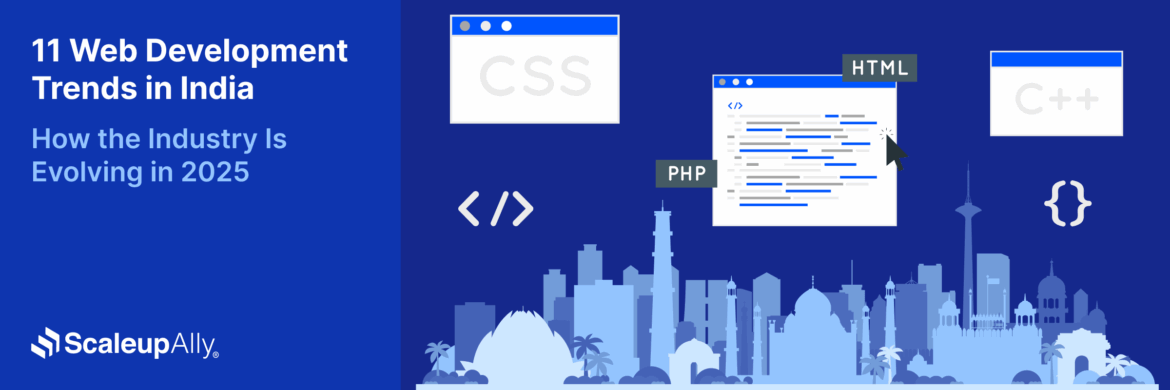
21 Web Development Trends to Watch Out in 2025
Suprabhat Sen | April 27, 2025 , 17 min read
Table Of Content
A blink is a fraction of a second (50 milliseconds to be exact). Within this timeframe, a visitor has already judged your website and decided whether to stay or bounce.
Users’ judgment is brutal, but we can’t blame them. About a decade ago, having just a website for your business was enough to get visitors excited and keep them around to take action. Today, users demand experiences where their needs are constantly anticipated before they are even consciously formed.
Though the stated fact may seem impossible to achieve, it is still possible to grab visitors’ attention the second they land on your website with these 21 web development trends we are about to uncover in this blog. Let’s get started.
Key Takeaways
- First impressions happen in 50 milliseconds, and within this timeframe, your site’s design will make or break user trust before they even read your content.
- UX isn’t optional anymore when 77% of agencies identify poor UX as their clients’ biggest weakness. It’s clear that how your site works matters more than what it says.
- Mobile is dominating with 58% of global e-commerce happening on mobile devices. The need to design for “mobile-first” is non-negotiable at this point.
- Every second of delay costs you 7% in conversions. This makes performance optimization a direct revenue strategy.
- With nearly 60% of recruiters hunting for web development skills, professionals that can’t attract or develop this expertise will fall critically behind.
Why Staying Updated with Web Development Trends Matters?
Fall behind on web development trends, and you might as well be handing your customers to competitors. It is as simple as that.
Users now abandon websites that take longer than 3 seconds to load, and this is costing businesses billions of dollars in lost revenue annually.
When Google shifted to mobile-first indexing, countless “desktop-only” optimized websites vanished from search results overnight. Those who paid attention at the time prospered, and the others who ignored it suffered devastating traffic losses, with some reporting 70%+ drops.
For businesses, the conversation of the latest trends in web development isn’t optional if you care about your business’s growth. Take, for example, accessibility. It was once considered a “nice-to-have” feature. But if we are considering the now over 11,000 ADA-related website lawsuits filed in the US alone, ignoring a standard like accessibility is legally dangerous.
Or security. Businesses that have implemented the latest security protocols from emerging web development trends suffered 72% fewer successful breaches than those using outdated measures.
So there’s a clear pattern here: those who track and implement relevant web development new trends create resilience; those who don’t create vulnerabilities.
We are not saying chase every new trend. All we are saying is, be strategic and be aware of your surroundings (understand which trends align with your business goals and which represent shifts you cannot afford to miss). Your competitors are watching. Are you?
Must-Know Web Development Trends in 2025
The web as it is today is not what it was yesterday. Definitively, tomorrow, it won’t be what it is today. The web is constantly evolving, and standing still means falling behind.
The 21 trends we have listed below are not wishful thinking. They are what’s between the relevance of your website and obsolescence.
The only question is whether you will adopt them and lead this transformation or you will ignore them and struggle to catch up later.
1. Prioritize User Experience in Web Development
Apart from the fact that a poor user experience is annoying, it’s costing businesses lots of money. SoDA has stated that 77% of of agencies identify poor UX as one of their clients’ most significant weaknesses. This isn’t surprising when nearly half of all consumers (46%) judge websites based on visual appeal and aesthetics.
Development teams need to start integrating UX specialists from day one rather than bringing them in for last-minute polishing. It is perhaps why we are seeing a rise in the “experience engineering” as a discipline.
2. Standardizing Dark Mode Across the Web
Dark mode, which started as a niche prioritization, has now become a mainstream expectation. Websites that offer dark mode have seen 30% higher engagement rates.
Browsers universally now support the prefers-color-scheme media query, which has made dark mode implementation more standardized.
Perhaps we can look at this trend in another light. It is time we recognized dark mode as an accessibility feature and not just a visual preference. For users with light sensitivity, migraines, or certain visual impairments, dark mode makes browsing for longer hours physically possible. The inclusivity of this design makes it one of the most impactful web development trends of recent years.
3. Speed as a Business Strategy
With a single second of delay causing a 7% drop in conversions, optimizing your website for performance directly impacts revenue. The latest website development trends show companies investing in speed infrastructure. Content Delivery Networks (CDNs) that improve load times by up to 60% are now standards for all businesses of all sizes and not only enterprise operations.
Pre-rendering, code splitting, and tree-shaking have become fundamental strategies that are mandatory. Mobile performance receives particular attention, with techniques like dynamic resource loading based on connection quality becoming standard practice.
In competitive markets, milliseconds matter, and so it is necessary to make speed optimization a strategic differentiator rather than a technical checkbox.
4. Designing for Mobile as the New Baseline
58% of global e-commerce sales now happen on mobile devices. Pair that with the projection of over 1 billion 5G connections worldwide by 2025, and the direction is clear. Mobile optimization is the default starting point. Companies that implement true mobile-first designs have seen conversion rates improve by 20% on average.
Development workflows have evolved accordingly. Teams now prototype on mobile before expanding to desktop. This has reversed what used to be the norm traditionally. Among web development trends in 2025, this complete inversion of the traditional desktop-to-mobile design hierarchy represents one of the most significant shifts.
5. Unified Digital Experiences Everywhere
90% of consumers expect consistent interactions across channels. For that matter, at the center of 2025’s web development trends should be seamless omnichannel integration. The standalone website has evolved into just one touchpoint in a connected ecosystem.
Progressive web apps serve as bridges between web and native mobile experiences. Shopping carts sync instantly between devices. Customer service conversations transfer seamlessly from chatbot to human agent, carrying full context across channels.
Development teams are reorganizing around customer journeys rather than channels, with cross-functional squads tackling entire user flows instead of isolated touchpoints. This organizational shift, combined with API-first technical practices, enables the continuity modern consumers demand, where no interaction exists in isolation.
6. The Rise of Jamstack-Centric Development
In the past year, there has been a 50% increase in Jamstack adoption. This architecture, emphasizing pre-rendered content served from CDNs, delivers the performance modern users demand while simplifying development workflows.
The Jamstack’s way separates the frontend presentation layer from backend systems, allowing specialized tools to handle each concern. Static site generators like Next.js, Gatsby, and Astro continue gaining traction, while headless CMS platforms offer content management flexibility without dictating front-end implementation.
This architecture is noticed particularly in e-commerce, where milliseconds matter. By pre-rendering product pages and dynamically injecting personalized elements, Jamstack sites deliver lightning-fast initial loads with the personalization shoppers expect. Security improves as well, with reduced server-side attack surfaces.
7. Simplifying Checkout to Maximize Conversions
Cart abandonment statistics reveal that 30% of shoppers abandon purchases due to complicated checkout processes. This consumer impatience has triggered revolutionary changes in checkout design, making payment one of the most financially impactful web development trends of 2025.
Companies implementing streamlined checkouts consistently report conversion improvements of 15-30%. In a competitive e-commerce market, the checkout experience has become as important as product and price in determining market success.
8. Hyper-Personalization with AI
AI is transforming web experiences from one-size-fits-all to individually tailored. With 75% of businesses expected to use AI-driven web technologies by the end of 2025, personalization at scale has become one of the defining web development trends of the year.
Today’s implementation goes far beyond showing recently viewed products. AI systems analyze browsing patterns, purchase history, and even mouse movements to deliver unique experiences to each visitor. Page layouts adjust to match individual preferences. Content emphasis changes based on behavior patterns. Even color schemes adapt to optimize engagement for different user segments.
The personalization extends to customer support, where AI-powered chatbots improve efficiency by 60% while delivering increasingly human-like interactions. These systems now handle complex queries, recognize emotional cues, and seamlessly transfer to human agents when necessary.
9. The Evolved Node.js Ecosystem
With 40.8% of developers now using Node.js, its ecosystem has reached unprecedented maturity. What began as a server-side JavaScript runtime has evolved into a comprehensive development ecosystem supporting enterprise-scale applications.
The latest web development trends show Node.js expanding beyond its traditional API server role. Serverless Node.js functions power microservice architectures. Node-based build tools like Vite and Turbopack accelerate development workflows. Testing frameworks like Playwright simplify cross-browser testing.
The ecosystem’s true strength lies in its package ecosystem. npm remains the world’s largest software registry. This vast library of pre-built functionality accelerates development while modern tooling manages the complexity of dependencies. For teams balancing innovation speed with maintainability, the Node.js ecosystem provides an increasingly attractive foundation.
10. Progressive Web Apps (PWAs) Mainstreaming
PWAs boast a 68% higher engagement rate than standard mobile websites. Their ability to deliver near-native experiences without app store gatekeeping has made them among the most consequential web development trends of recent years.
Modern PWAs leverage the full suite of web capabilities (push notifications, offline functionality, home screen installation, and hardware access) while maintaining the web’s inherent discoverability. Advanced caching strategies deliver instant loading on repeat visits.
11. WordPress Reinvented for Modern Development
WordPress powers 40% of all websites globally, but its role is evolving. No longer just a blogging platform or traditional CMS, WordPress in 2025 is transforming into a comprehensive digital experience platform with headless capabilities at its core.
Perhaps most significantly, WordPress’s REST API has enabled headless implementations where WordPress manages content while modern frontend frameworks deliver the presentation layer. This architecture combines WordPress’s content management strengths with the performance benefits of JavaScript frameworks.
12. Security-First Development
With 25% of data breaches stemming from web app vulnerabilities and cyberattacks on websites rising 56% year-over-year, security has shifted from afterthought to foundational principle. The latest web development trends show security considerations influencing every development decision.
User behavior reflects this priority. 85% now avoid websites without HTTPS. SSL certificates have become table stakes, improving both security and SEO rankings. Advanced implementations leverage HSTS (HTTP Strict Transport Security) and certificate pinning to prevent sophisticated interception attacks.
13. Visual Search Integration
Visual search functionality (allowing users to upload images to find similar products or information) represents one of the most transformative web development trends of 2025. The technology leverages advanced computer vision algorithms to understand image content and context.
Implementation has become simpler with the emergence of specialized APIs from cloud providers. These services handle the complex machine learning aspects while developers focus on integration and user experience. Browser-based machine learning models enable basic visual analysis directly in the browser without server round trips.
The impact on e-commerce is particularly profound. Shoppers can photograph items they encounter in daily life and instantly find similar products. Interior design sites let users upload room photos to discover matching furniture. Fashion retailers enable outfit matching from inspiration images.
Companies implementing visual search report substantial engagement improvements. Users who engage with visual search convert at rates 3-5x higher than traditional browsers. For visually oriented product categories, this functionality has evolved from novelty to competitive necessity.
14. Clear Call-to-Action (CTA) Design Systems
With clear CTAs improving conversions by 62%, their design has become one of the most scrutinized aspects of web development.
Modern CTA systems use hierarchical visual language to communicate relative importance; primary actions receive high-contrast treatment while secondary options use more subtle styling. Position, size, and whitespace carefully guide user attention. Micro-interactions provide subtle feedback, reinforcing the interactive nature of these elements.
Perhaps most significantly, companies now track “CTA clarity scores” as key metrics, measuring how quickly users identify the primary action on each page. This focus on clarity over creativity reflects a maturing understanding that the most beautiful button is worthless if users don’t recognize it as clickable.
15. Blockchain Integration
Blockchain technology is expanding beyond cryptocurrency into mainstream web applications, with adoption projected to grow 35% this year. This integration represents one of the most technically complex web development trends of 2025, but also one with profound implications for trust and transparency.
Technical implementation has simplified dramatically with specialized APIs abstracting blockchain complexity. Developers can now implement basic blockchain functionality without deep cryptographic expertise. Web3 libraries provide standardized interfaces for wallet connections and smart contract interactions.
16. Research-Based Design Process
The days of design by opinion are ending. Modern web development embraces a research-driven approach throughout the design process. With 42% of users abandoning websites due to poor functionality despite liking the products, data-backed design decisions have become critical to business success.
During development, usability testing validates assumptions with real users. A/B testing quantifies the impact of design choices. Session recordings identify unexpected usage patterns. Heatmaps visualize attention distribution. This continuous feedback loop ensures designs solve actual problems rather than imagined ones.
17. Transforming User Engagement with Video
Websites incorporating video see an 80% higher engagement rate—a statistic driving a complete rethinking of video’s role in web experiences. Once treated as optional rich media, video has become a core content type integrated throughout the user journey.
Interactive video elements represent the cutting edge, allowing users to make choices affecting narrative direction or explore 3D objects within the video frame. For industries where showing outperforms telling, these advanced video integrations transform passive consumption into active exploration.
18. Accessibility as Standard Practice
With the rise in ADA-related lawsuits against websites, accessibility has become one of the non-negotiable web development trends of 2025.
Technical implementation now leverages advanced tools throughout the development process. Automated testing catches basic issues during coding. Screen reader compatibility testing verifies keyboard navigation and proper ARIA attributes. Color contrast analyzers ensure readability across visual conditions.
19. Research-to-Purchase Path Optimization
Consumer research patterns have changed: 66% conduct research on desktop devices while 15% research on mobile devices at home before purchasing. This multi-device journey has made research-to-purchase path optimization one of the most financially impactful web development trends of 2025.
Cross-device continuity preserves shopping carts and browsing history across platforms. Synchronized wishlists capture research-phase interest for later conversion. One-click transitions from informational content to purchase options reduce abandonment during intent shifts.
Companies mastering this optimization recognize that purchase journeys rarely follow linear paths. By accommodating natural browsing patterns rather than forcing predetermined funnels, they capture revenue from modern shopping behaviors that traditional e-commerce models miss entirely.
20. AI-Driven Development Assistance
AI isn’t just changing what we build, it’s transforming how we build it. With 75% of businesses expected to leverage AI development tools by year-end, AI assistance has become one of the most transformative web development trends for practitioners themselves.
The impact on development velocity is substantial. Tasks that once required days now complete in hours. Junior developers leverage AI assistance to produce work approaching senior quality. Specialists in one technology stack can contribute meaningfully across unfamiliar technologies with AI guidance.
Rather than replacing developers, these tools elevate their work, handling routine implementation details while humans focus on creative problem-solving and user empathy. For organizations balancing quality expectations with resource constraints, AI-assisted development provides a compelling competitive advantage.
21. Zero-Trust Security Architecture
Traditional security approaches assumed external threats and internal trustworthiness. In 2025, zero-trust architecture (assuming nothing is safe by default) has become one of the defining web development trends in response to rising cyberattacks (up 56% year-over-year).
This verifies every access attempt regardless of source. Authentication becomes continuous rather than session-based, with periodic reverification throughout user sessions. Authorization checks occur at each resource request rather than once at login. Network segmentation limits damage from any single breach.
Beyond technology, zero-trust represents a philosophical shift, acknowledging that breaches are inevitable and designing systems to contain rather than prevent them. For organizations handling sensitive data, this approach offers resilience against increasingly sophisticated threats while maintaining usability through contextual security that adjusts based on risk assessment.
Future of Web Development
Web development is on fire right now. Look around and you’ll see why. Nearly a quarter of companies have built dedicated web dev teams. Not shared resources, not “also handles our website” people, but dedicated specialists who do nothing but craft digital experiences.
38% of developers are chasing web skills, making it the most pursued specialty in tech, you know something’s happening. Recruiters feel the pressure too. Back in 2023, almost 60% were hunting for web development talent. Not preferring it. Actively hunting for it.
All these stats point to the fact that everything is becoming web-based. Internal tools, Customer experiences, Sales channels, Administrative systems, etc. The web is where business happens.
For anyone plotting their career path, the message couldn’t be clearer. Web development skills aren’t just employable, but are becoming essential in a digital-first world where your website isn’t just your storefront. It’s your entire business.
Conclusion
The 21 trends we’ve explored aren’t academic exercises or far-future speculation. They’re happening now. Some companies will read this and nod along, filing it under “interesting but not urgent.” They’ll keep their multi-second load times. They’ll postpone mobile optimization for another quarter. They’ll treat UX as decoration rather than a foundation. They won’t be around in 2026.
The brutal efficiency of the digital marketplace doesn’t allow for complacency. Users won’t articulate why they bounce from your site, they’ll just leave, taking their attention, their data and their wallets with them. In 50 milliseconds, they’ve already decided.
That’s why forward-thinking businesses are already investing in modern web development services to meet user expectations in real-time and deliver measurable impact.
The companies that thrive won’t just adopt these trends, they’ll weaponize them. They’ll turn speed into conversion advantages. They’ll leverage AI not as a novelty but as a competitive edge. They’ll transform security from cost center to trust builder.
Web development is undergoing a Darwinian evolution where only the adaptable survive. Now the question is, would you implement these trends before your competitors do?
Frequently Asked Questions
Q: Is AI the future of web development?
AI isn’t the future of web development—it’s the present. AI now handles repetitive tasks while developers focus on creative solutions. The best developers aren’t fighting this, they’re using AI as an amplifier for their human creativity and problem-solving skills.
Q: How do web development trends impact SEO?
Web development trends directly impact SEO through page speed, mobile responsiveness, and user experience. These are all core ranking factors. Google’s algorithm updates increasingly favor sites that adopt these trends. Put simply: when you build sites according to current best practices, you’re simultaneously building for better search visibility.
Q: Which frontend frameworks are most popular in 2025?
React maintains its dominant position, though Svelte continues gaining market share due to its performance advantages. Vue remains popular for mid-size projects, while Next.js has become the default for React-based applications needing server-side rendering. The real story isn’t which framework wins, but how specialized tooling has emerged for different use cases.
Related Blogs

11 Web Development Trends in India: How the Industry Is Evolving in 2025
Discover the top web development trends in India shaping 2025. Explore innovations, industry insights, and the future of web development.
Suprabhat Sen
Sep 30 ,
8 min read

Laravel + Elasticsearch: Smart Search for E-commerce in 2025
Learn how to integrate Elasticsearch with Laravel, from setup and configuration to indexing. Improve your app's search performance using Laravel Elasticsearch.
ScaleupAlly Team
Jul 3 ,
15 min read

How long does it take to build an ecommerce website?
Discover the timeline for creating an eCommerce website. Learn how long it takes to build an eCommerce site and get started today! Expert insights await.
Manu Jain
Jun 1 ,
12 min read


